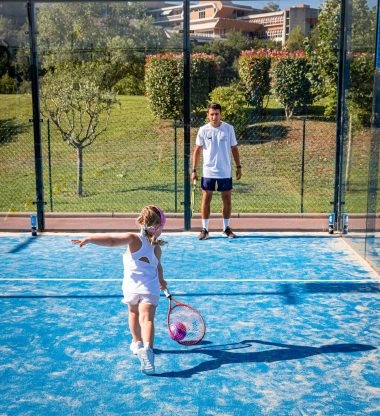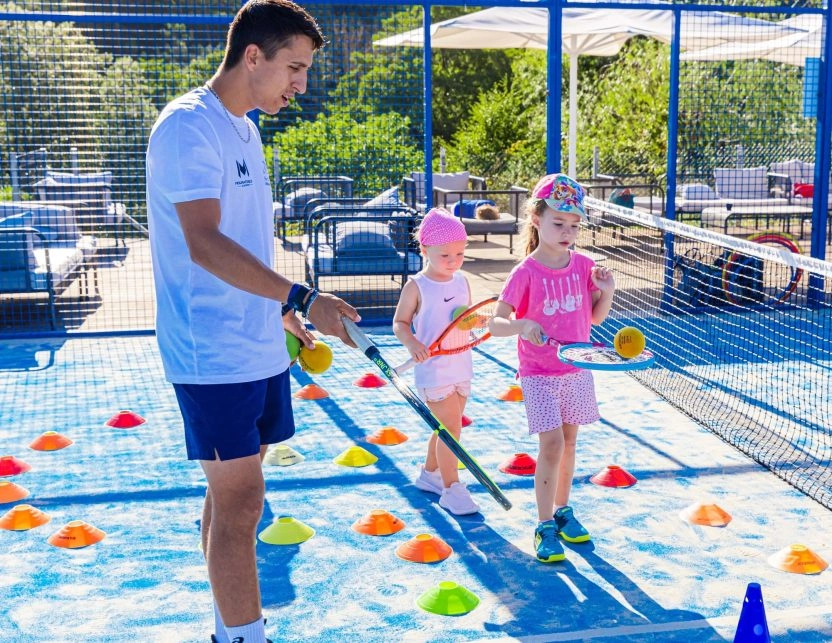The foam tennis ball is an essential tool for beginners, children and players wishing to learn tennis gradually. Lighter and slower than a traditional tennis ball, it allows you to learn the basics without risking injury or bad technical habits. It’s particularly recommended for baby tennis courses, where younger players can discover the sport in a fun and appropriate way. In this article, we’ll explore the characteristics of the foam tennis ball, its advantages, its use for different levels of play, and give you advice on how to choose the right foam tennis balls for your needs.
1. What is a foam tennis ball?
Composition and characteristics
Foam tennis balls are made from synthetic foam, making them light and flexible:
- Lightweight: Compared with traditional tennis balls, foam balls are much lighter, giving beginners greater control over their shots.
- Slightly larger size: These balls are often larger than traditional balls, making them easier for young players to handle.
- Controlled bounce : The bounce of foam balls is lower and slower, making them ideal for beginners and children.
Why use a foam tennis ball?
The foam tennis ball is specially designed to make learning tennis easier:
- Suitable for beginners: It allows new players to concentrate on their technique without being hampered by the speed or hardness of traditional balls.
- Safety : Thanks to their light weight, these balls are ideal for playing indoors or on smaller surfaces, reducing the risk of injury or material damage.
- Mouratoglou methodology : In modern teaching approaches such as the Mouratoglou methodology, foam balls play an essential role in supporting the early stages of learning. They enable the focus to be on movement, precision and the development of players’ confidence, while incorporating progressive exercises adapted to their age and level. This type of approach emphasises fluid progression, making each stage of training accessible and motivating.
2. The advantages of foam tennis balls
Progressive learning
One of the main advantages of foam tennis balls is that they facilitate progressive learning:
- Better control: The slower pace of the ball allows beginners to better control their shots and perfect their technical movements.
- Reduced frustration: The slower pace reduces the risk of frequent errors, helping to keep new players motivated.
Safety for young players
Foam balls are ideal for children and young beginners because of their safety:
- Soft impact: The foam absorbs the impact of shots, making these balls safer for children learning to play.
- Risk-free training : Children can train in complete safety, without fear of injuring themselves or breaking objects during indoor sessions.
Versatility and indoor use
The foam tennis ball is ideal for versatile use:
- Indoor play: Thanks to its light weight and low impact, this ball is perfect for training indoors, whether at home or in a gym or sports hall.
- Play on smaller fields: It’s also suitable for smaller spaces, such as mini-tennis courts or improvised courts in unconventional environments.
3. How do I use a foam tennis ball?
Introduction to tennis for children
The foam tennis ball is a popular teaching tool for introducing children to tennis:
- Warm-up and coordination: Before using traditional balls, young players can practise throwing, catching and hitting the foam tennis ball to improve their coordination.
- Group play: Foam balls are perfect for group activities and educational games that promote tennis learning in a fun way.
Perfecting basic techniques
Foam balls can also be used by adults and beginners to perfect basic tennis techniques:
- Work on shot placement : Because they are so slow, foam balls allow you to work on your shot placement without having to concentrate solely on speed.
- Improving consistency : They enable players to develop their consistency and work on longer exchanges.






How do I choose a foam tennis ball?
Selection criteria
When buying foam tennis balls, there are several criteria to consider:
- Size: Foam balls come in different sizes. For young children, larger balls will make it easier to hold and learn.
- Density : Some foam balls are denser than others. Less dense balls will bounce higher, while denser balls will offer a more controlled bounce.
- Brands : Choose balls from brands renowned for their quality and durability. Some brands offer foam balls specially designed for beginners or budding players.
Use adapted to your level
The choice of foam tennis ball should also be adapted to the player’s level:
- Complete beginners: Opt for a slower, softer ball offering excellent control.
- Children: Larger, lower-density balls are ideal for young players new to tennis.
5. Mistakes to avoid with foam tennis balls
Using the ball on unsuitable surfaces
Although the foam tennis ball is versatile, some surfaces are not suitable:
- Avoid rough surfaces : Playing on rough surfaces such as concrete can wear out the foam quickly. Opt for smoother surfaces to extend the life of the ball.
- Do not use on large courts: Foam balls are designed for small courts. Using them on normal-sized courts can make exchanges difficult.
Not changing balls at the right time
It’s important to switch to a classic tennis ball once you’ve mastered the basics:
- Switching at the right time : Once you have acquired a good hitting technique and greater consistency with the foam ball, it is advisable to switch to intermediate balls before using standard balls.
Conclusion

The foam tennis ball is an excellent learning tool for young players and beginners. It helps develop technical skills thanks to its lightness, controlled bounce and safety. Used for training purposes, whether indoors or on smaller courts, the foam ball offers many advantages for smooth progress. Remember to choose the right ball for your level and specific needs to maximise your performance and enjoyment of the game.









